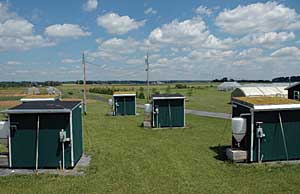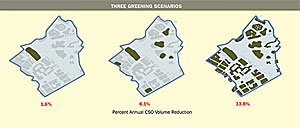Rooftops Slowly, but Steadily, Start to Sprout
Toxic cocktail
A model of the type that Earth Pledge is developing could be particularly useful in cities with older, overtaxed combined sewer systems that transport both storm water and sewage. About half the time it rains in New York, for example, the volume of raw sewage and contaminated storm water exceeds the system's capacity. These occurrences, known as combined sewer overflows (CSOs), result in the release of this toxic mix directly into the city's surrounding waters.
Earth Pledge has so far built out the model with building-stock data, land-use characteristics, and infrastructure information for one sewer-shed subbasin in Lower Manhattan. The model predicts a 34 percent reduction in the volume of CSOs if all buildings in the study area were covered with green roofs. The reduction in the number of incidences of CSOs would be minimal due to the high percentage of impervious surfaces in the selected sewer shed, according to Earth Pledge. The group hopes to license the model to other cities, incorporating their rainfall and infrastructure data.
The storm-water model is part of a larger Earth Pledge green roof project. About a year ago, the group installed a 35,000-square-foot green roof on top of Silver Cup Studios in Long Island City, Queens, and is monitoring its thermal performance and storm-water-management capabilities. It will also monitor a 10,000-square-foot green roof that it is now installing on top of a warehouse in the same New York City neighborhood. Data from both sites will be used to test and refine the model.
| Click image for larger view |
| Penn State University Center for Green Roof Research A green roof can keep buildings cooler in summer (above) and can therefore help save on air- conditioning costs, according to studies conducted at PSU's Center for Green Roof Research (below). This strategy makes most sense in regions with long cooling seasons. Photography: © Pennsylvania State University |
 |
Storm-water issues are not the only area of current green roof investigation and modeling. One of several topics of study at the Pennsylvania State University (PSU) Center for Green Roof Research is the potential for green roofs' evaporative cooling to ameliorate the urban heat-island effect. PSU's facilities consist of six garden-shedlike wood-framed buildings that are heated and cooled. Three of these buildings have green roofs, while the other three have conventional roofs and serve as experiment controls, explains Robert D. Berghage, associate professor of horticulture. He tracks the temperatures on the test buildings' roofs and then determines the impact at the city scale through modeling.
Brad Bass, an adjunct professor at the Center for the Environment at the University of Toronto, has developed a modeling tool that can predict how much energy can be saved by including a green roof on an individual building. It takes into account such factors as local climate data, building configuration, and regional construction practices. Some researchers caution, however, that a green roof employed merely as an energy-saving device may not make economic sense to a building owner in a climate with a short cooling season.
PSU tests confirm that the insulative properties of green roofs reduce thermal loading and therefore can help save on air-conditioning costs. However, green roofs also prevent desirable heat during winter, says Berghage. But he points out that use of green roofs in climates with short cooling seasons could still have advantages. Widespread adoption of measures like green roofs that help cut energy use in the summer, the season associated with peak utility loads, could reduce the need for additions to the power-generation infrastructure. "Although this may not translate into a benefit for an individual owner, there is a societal benefit."











